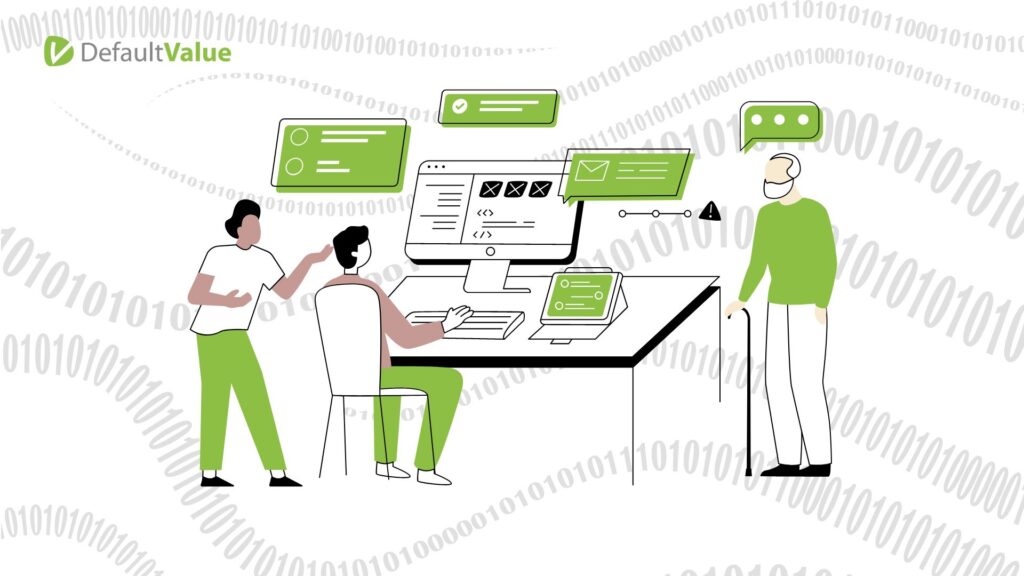What is headless commerce, and how does it help online store
Have you ever thought, “My content management system is handy, but I don’t like the eCommerce plugin”?
Or, “I want my designers and marketers to have full access over omnichannel store design.”
If so, you definitely need to move to headless eCommerce. Trust us, we at Default Value know what we’re talking about.
eCommerce continues to grow and, with each passing year, is becoming more complex and competitive. Developers and business owners are trying to find new ways to improve their online stores, and one of the most promising solutions today is headless commerce. According to the State of Commerce report by Salesforce, 77% of companies using headless architecture say it gives them more flexibility and allows them to make changes to their store faster. In addition, they report that 80% of companies that do not use headless architecture plan to implement it in the next two years.
Do you know who has already switched to headless eCommerce? For example, Nike, Boretti, Staples, Ace and Tate, Veloretti, and many others. So the world-famous brands can already confirm: headless architecture—it’s fantastic!
We at Default Value have over 13 years of experience in Magento development and extensive experience creating headless commerce and PWAs. We are ready to help you create a fast, flexible, and scalable website with headless commerce that will keep your business running smoothly. In this article, we will cover all aspects of headless commerce to help you make the right decision and implement this technology in your business.
What does headless commerce really mean?

Headless commerce is an eCommerce concept that separates user interface and business logic. In the traditional approach to eCommerce, the user interface (UI) and the business logic (backend) are linked together and run on the same platform. However, these components can be separated and work independently in headless commerce.
In particular, headless commerce allows developers to create their own user interfaces that can be integrated into any platform using an API (Application Programming Interface). This means they can create customizable applications for any device or channel, such as mobile apps, IoT devices, or even voice assistants.
Meanwhile, business logic, such as inventory management, payment processing, and order management, remain within the platform. This allows businesses to use many user interfaces without worrying about affecting their business logic.
Headless commerce also provides a higher level of flexibility and scalability. Businesses can easily add new channels and devices without changing the underlying business logic. In addition, headless commerce allows for faster and more flexible responses to changes in customer needs and the market as a whole.
However, like any new technology, headless commerce may require additional infrastructure and development costs. It can also lead to more complex management and control of all components of the system.
What are the benefits of headless commerce?
Headless commerce is becoming increasingly popular among eCommerce stores and is taking over the market. Its benefits continuously attract stores that want to improve their online sales and provide customers with a better shopping experience.

Let’s look at some of the main advantages of headless commerce.
- Flexibility and scalability. Headless commerce separates the user interface and business logic, allowing businesses to quickly and easily change their user interface and add new sales channels without changing the business logic. This means companies can quickly adapt to new market demands and changing customer needs.
- Better content management. Businesses can manage content on their sites and applications more effectively. With the flexible architecture of headless commerce, companies can easily create and modify content on their sites and apps, allowing them to respond quickly to news, promotions, events, and changes in product offerings.
- Better user experience. Headless commerce allows you to create customizable user interfaces that are optimized for specific devices and channels. This means businesses can provide their customers with the best possible user experience given the device or channel on which they use the site or app.
- Greater freedom in the choice of technology. Brands get the opportunity to use any preferred technology, including any programming language and content management system. This means that companies can use the best and most up-to-date technology for their needs, which can significantly improve business efficiency and productivity.
- Improved security. Headless commerce also provides maximum security for stores and their customers. Because the online shop does not store customer data on its servers, it minimizes the risks of a possible hacker attack on the server.
How does headless commerce impact your customers?

In the world of eCommerce, new technologies and concepts are constantly emerging and changing the way sellers and buyers interact. One of the main benefits of headless commerce for buyers is an improved user experience. Since it allows for a separation of frontend and backend, web developers get more freedom in creating interfaces and streamlining processes. This means that users can expect a faster, smoother, and more user-friendly interface, which in turn, can lead to increased conversions.
Another benefit of headless commerce for buyers is a more personalized experience. With the flexibility of a headless approach, businesses can easily integrate third-party systems such as content management systems and marketing tools. This gives the ability to provide personalized content and recommendations to shoppers, which can increase customer satisfaction and build loyalty.
In addition, headless commerce can also impact the buying process. For example, separating the front end and back end allows a business to use different sales channels, such as mobile apps or chatbots, making the buying process more convenient for customers.
Overall, headless commerce provides more freedom and flexibility to create products and services for customers, which can lead to a more convenient, personalized, and satisfying user experience.
Headless commerce vs. traditional commerce

Headless and traditional commerce are two different approaches to eCommerce. Traditional commerce involves a monolithic platform that manages all aspects of an online store, including frontend, backend, database, etc. Whereas headless commerce provides companies with a more flexible approach to online store management, allowing them to separate the frontend and backend.
Let’s summarize what we know about headless commerce at this moment. One of the main benefits of headless commerce is a more customizable user experience—companies can create customizable user interfaces that better match customer needs and preferences. In addition, the headless approach allows companies to use a variety of sales channels, including websites, mobile apps, social media, and marketplaces. This greatly expands the ability to sell products and reach new audiences.
| Traditional eCommerce | Headless eCommerce | |
| Architecture | Uses a monolithic architecture | Uses a distributed architecture |
| Flexibility | Is usually limited to one website | Is more flexible because it allows for different frontends for different sales channels |
| Scalability | Can have problems scaling with a large number of orders | Is more scalable because it makes it easy to add and remove website functionality |
| Speed of development | Requires more time to develop and test new features | Allows developers to work independently and quickly create new features |
| Security | May have only one entry point for intruders | Can be more secure because each microservice can be secured separately |
Traditional commerce has its advantages, such as a simpler management process and lower infrastructure costs. However, it limits companies’ ability to create a customizable user experience and use different sales channels.
Headless commerce provides greater flexibility and speed in changing the online store. With headless commerce, companies can quickly adapt to changing market demands and customer needs. This allows new features and improvements to be launched quickly without changing the entire platform, which is a major disadvantage of traditional commerce.
In addition, headless commerce allows companies to use various technologies and tools to improve their online stores. For example, a company can use specialized services to manage business logic and order processing, improving the online store’s security and quality.
Ultimately, headless commerce and traditional commerce have advantages and disadvantages, and the choice between the two depends on each company’s specific needs and goals. Traditional commerce may be the best choice for companies with limited budgets and simple requirements. At the same time, headless commerce may be the preferred choice for companies looking for a more flexible, customizable, and scalable approach to managing their online stores.
What is Magento Headless architecture?

Magento is one of the most popular and powerful open-source eCommerce platforms written in PHP and used to create online stores. However, with new technologies and consumer demands, developers began to look for new ways to use Magento. One such approach is the Magento headless architecture.
Magento headless architecture allows the frontend to be created using any programming language and technology, while the backend uses Magento as the CMS engine to manage business logic, orders, and inventory.
One of the main advantages of such architecture is the ability to create more flexible and customizable online stores. Developers have full control over the design and functionality of the front end, allowing them to create unique and innovative user interfaces and to adapt more quickly to changing user requirements.
What’s more, the flexibility of headless commerce allows you to meet the specific needs of each business. For example, when using headless commerce for Magento, you can integrate various systems and tools that can significantly improve the functionality of your online store. One example would be integration with a content management system, which allows you to manage content on the site easily, and add new pages, blogs, etc.
Headless commerce also allows the use of different sales channels, such as mobile applications, social networks, messengers, etc., which can greatly expand the audience of the online store and increase conversion rates.
In addition, a headless Magento store allows for a faster development process and lower development costs. Also, by not having to use the standard Magento frontend, you can create an entirely new interface without having to make complex modifications to the engine’s code.
However, like any approach, the headless Magento architecture has its drawbacks. First of all, it requires additional effort and skills from developers. In addition, problems can arise with integrating third-party systems that need to support the headless architecture.
Overall, Magento headless commerce is a powerful and flexible approach to creating online stores that can help companies improve user experience and business efficiency.
How is Magento 2 headless PWA going to affect eCommerce?

Magento 2 headless PWA is an innovative architecture that will change the eCommerce game. It removes device boundaries and allows users to interact with the store on any device. PWA is a progressive web app that combines the functionality of a website and a mobile app. It provides faster loading and smoother navigation, which increases the usability of the store. We’ve already talked more about Magento PWA in this article.
Magento 2 Headless PWA also improves the customer experience with more precise personalization. It promotes a deeper understanding of customer needs and preferences, allowing stores to provide each user with the most appropriate products and services.
Magento 2 Headless PWA also makes it easier for stores to integrate with third-party services and APIs. This allows you to expand the functionality of your store by adding new features and functions.
It is also important to note that using headless PWA with Magento 2 allows stores to reduce the cost of developing and maintaining mobile applications. Thanks to the unified architecture, stores can create apps that run on different platforms without developing and maintaining separate apps for each platform. This change has the potential to revolutionize eCommerce and turn the familiar game upside down.
Conclusions. How we can help with implementing headless commerce?
In conclusion, it’s safe to say that using headless commerce will bring huge benefits to your business in this digital transformation era. It will allow you to adapt quickly and flexibly to market demands, increase your site’s loading speed and performance, and improve the user experience.
Default Value has a wealth of experience in Magento development, including PWA and using Magento headless commerce. We value each of our clients and build long-term relationships to help clients’ businesses grow. Turning to us, you can be sure that your project will be implemented professionally and on time. We are ready to help with headless commerce implementation and innovative technologies to make your business thrive in the future.
If you’d like to learn more about headless commerce and how we can help you with its implementation, contact us today. We’d love to tell you about our expertise in this area and suggest solutions best suited for your business. Let’s take your eCommerce project to the next level together!




